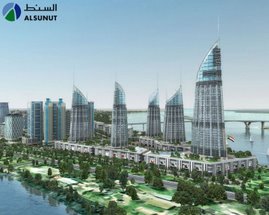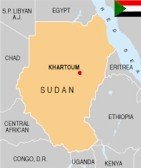Friday 8 June 2007
Wednesday 2 May 2007
Wednesday 11 April 2007
Wednesday 4 April 2007
Tuesday 3 April 2007
sudan Geography


Sudan is situated in northern Africa, bordering the Red Sea and it has a coastline of 853km along the Red Sea.[21] With an area of 2,505,810 square kilometres (967,499 sq mi), it is the largest country in the continent and tenth largest in the world. It borders the countries of Central African Republic, Chad, Democratic Republic of the Congo, Egypt, Eritrea, Ethiopia, Kenya, Libya and Uganda. It is dominated by the River Nile and its tributaries.
The terrain is generally flat plains, broken by several mountain ranges; in the west the Jebel Marra is the highest range; in the south is the highest mountain Mount Kinyeti Imatong, near the border with Uganda; in the east are the Red Sea Hills.[22]
The Blue and White Niles meet in Khartoum to form the River Nile, which flows northwards through Egypt to the Mediterranean Sea. Blue Nile's course through Sudan is nearly 500 miles long and is joined by the rivers Dinder and Rahad between Sennar and Khartoum. The White Nile within Sudan has no significant tributaries.
The amount of rainfall increases towards the south. In the north there is the very dry Nubian desert; in the south there are swamps and rain forest. Sudan’s rainy season lasts for about three months (July to September) in the north, and up to six months (June to November) in the south. The dry regions are plagued by sand storms, known as haboob, which can completely block out the sun. In the northern and western semi-desert areas, people rely on the scant rainfall for basic agriculture and many are nomadic, traveling with their herds of sheep and camels. Nearer the River Nile, there are well-irrigated farms growing cash crops.[23]
There are several dams on the Blue and White Niles. Among them are the Sennar and Roseires on the Blue Nile, and Jebel Aulia dam on the White Nile. There is also Lake Nubia on the Sudan-Egyptian border.
Rich mineral resources are available in Sudan including: petroleum, natural gas, gold, silver, chrome, asbestos, manganese, gypsum, mica, zinc, iron, lead, uranium, copper, kaolin, cobalt, granite, nickel and tin.[24]
Desertification is a serious problem in Sudan.[25] There is also concern over soil erosion. Agricultural expansion, both public and private, has proceeded without conservation measures. The consequences have manifested themselves in the form of deforestation, soil desiccation, and the lowering of soil fertility and the water table.[26]
The nation's wildlife is threatened by hunting. As of 2001, 21 mammal species and 9 bird species are endangered, as well as 2 types of plants. Endangered species include: the waldrapp, northern white rhinoceros, tora hartebeest, slender-horned gazelle, and hawksbill turtle. The Sahara oryx has become extinct in the wild.[27]
Sunday 1 April 2007
Khartoum

Khartoum was founded in 1821 by Muhammad Ali , the ruler of Egypt, as an outpost for the Egyptian army, but grew as a regional center of trade, including the slave trade. Troops loyal to the Mahdi Muhammad Ahmad laid siege to Khartoum starting on March 13, 1884 against the defenders led by British General Charles George Gordon, resulting in the massacre of the Anglo-Egyptian garrison.
The heavily damaged city fell to the Mahdists on January 26, 1885. Omdurman was the scene of the bloody battle (September 2, 1898) in which British forces under Sirdar Horatio Kitchener defeated the Mahdist forces defending the city.
In 1899 Khartoum became capital of Anglo-Egyptian Sudan and, with the independence of Sudan in 1956, the capital of the new country.
The heavily damaged city fell to the Mahdists on January 26, 1885. Omdurman was the scene of the bloody battle (September 2, 1898) in which British forces under Sirdar Horatio Kitchener defeated the Mahdist forces defending the city.
In 1899 Khartoum became capital of Anglo-Egyptian Sudan and, with the independence of Sudan in 1956, the capital of the new country.
ताकें फ्रॉम http://en.wikipedia.org/wiki/Khartoum
Saturday 31 March 2007
Economy of Sudan


Despite new economic policies and infrastructure investments, Sudan still faces formidable economic problems as it must rise from a very low level of per capita output. Since 1997 Sudan has been implementing the macroeconomic reforms recommended by the IMF. In 1999, Sudan began exporting crude oil and in the last quarter of 1999 recorded its first trade surplus. Increased oil production (the current production is about 520,000 barrels per day) revived light industry, and expanded export processing zones helped sustain GDP growth at 6.1% in 2003. These gains, along with improvements to monetary policy, have stabilized the exchange rate. Currently oil is Sudan's main export (363,000 barrels per day), and the production is increasing dramatically. With rising oil revenues the Sudanese economy is booming at a growth rate of nearly 7% in 2005.
Agriculture production remains Sudan's most important sector, employing 80% of the work force and contributing 39% of GDP, but most farms remain rain-fed and susceptible to drought। Chronic instability — including the long-standing civil war between the Muslim north and the Christian/animist south, adverse weather, and weak world agricultural prices — ensure that much of the population will remain at or below the poverty line for years.
ताकें फ्रॉम http://en.wikipedia.org/wiki/Sudan
Agriculture production remains Sudan's most important sector, employing 80% of the work force and contributing 39% of GDP, but most farms remain rain-fed and susceptible to drought। Chronic instability — including the long-standing civil war between the Muslim north and the Christian/animist south, adverse weather, and weak world agricultural prices — ensure that much of the population will remain at or below the poverty line for years.
ताकें फ्रॉम http://en.wikipedia.org/wiki/Sudan
Friday 30 March 2007
First Sudanese Civil War

The year before independence, a civil war began between Northern and Southern Sudan. The Southerners, anticipating independence, feared the new nation would be dominated by the North.
Historically, the north of Sudan had closer ties with Egypt and was predominantly Arab and Muslim while the south was predominantly black, with a mixture of Christianity and Animism. These divisions had been further emphasized by the British policy of ruling the North and South under separate administrations. From 1924 on it was illegal for people living above the 10th parallel to go further south and for people below the 8th parallel to go further north. The law was ostensibly enacted to prevent the spread of malaria and other tropical diseases that had ravaged British troops, as well as to prevent Northern Sudanese from raiding Southern tribes for slaves. Another reason was to facilitate spreading christianity among the predominantly animist population while stopping the arabic and islamic influence from advancing south. The result was increased isolation between the already distinct north and south and arguably laid the seeds of conflict in the years to come.
The resulting conflict, known as the First Sudanese Civil War, lasted from 1955 to 1972. In 1972, a cessation of the north-south conflict was agreed upon under the terms of the Addis Ababa Agreement, following talks which were sponsored by the World Council of Churches. This led to a ten-year hiatus in the national conflict
Historically, the north of Sudan had closer ties with Egypt and was predominantly Arab and Muslim while the south was predominantly black, with a mixture of Christianity and Animism. These divisions had been further emphasized by the British policy of ruling the North and South under separate administrations. From 1924 on it was illegal for people living above the 10th parallel to go further south and for people below the 8th parallel to go further north. The law was ostensibly enacted to prevent the spread of malaria and other tropical diseases that had ravaged British troops, as well as to prevent Northern Sudanese from raiding Southern tribes for slaves. Another reason was to facilitate spreading christianity among the predominantly animist population while stopping the arabic and islamic influence from advancing south. The result was increased isolation between the already distinct north and south and arguably laid the seeds of conflict in the years to come.
The resulting conflict, known as the First Sudanese Civil War, lasted from 1955 to 1972. In 1972, a cessation of the north-south conflict was agreed upon under the terms of the Addis Ababa Agreement, following talks which were sponsored by the World Council of Churches. This led to a ten-year hiatus in the national conflict
Early history of Sudan

Three ancient kings of the Kushite kingdomsexisted consecutively in northern Sudan। This region was also known asNubia and Meroë, and these civilizations flourished mainly along the Nile River from the first to the sixth cataracts. The kingdoms were influenced by, and in turn influenced Pharaonic Egypt. when the Napatan Dynasty was founded under Alara and regained independence for the kingdom of Kush. Borders, however, fluctuated greatly. The country's dense population made it a problem however.
Much of the region was converted to Coptic Christianity during the third and fourth centuries AD. Islam was introduced in 640 AD with an influx of Muslim Arabs who had conquered Egypt, although the Christian Kingdoms of Nubia managed to persist until the 15th Century.
A merchant class of Arabs became economically dominant in feudal Sudan. An important kingdom in Nubia was the Makuria, which reached its height in the 8th-9th centuries, and was of the Melkite Christian faith, unlike its Coptic neighbours, Nobatia and Alodia
Much of the region was converted to Coptic Christianity during the third and fourth centuries AD. Islam was introduced in 640 AD with an influx of Muslim Arabs who had conquered Egypt, although the Christian Kingdoms of Nubia managed to persist until the 15th Century.
A merchant class of Arabs became economically dominant in feudal Sudan. An important kingdom in Nubia was the Makuria, which reached its height in the 8th-9th centuries, and was of the Melkite Christian faith, unlike its Coptic neighbours, Nobatia and Alodia
Subscribe to:
Posts (Atom)











